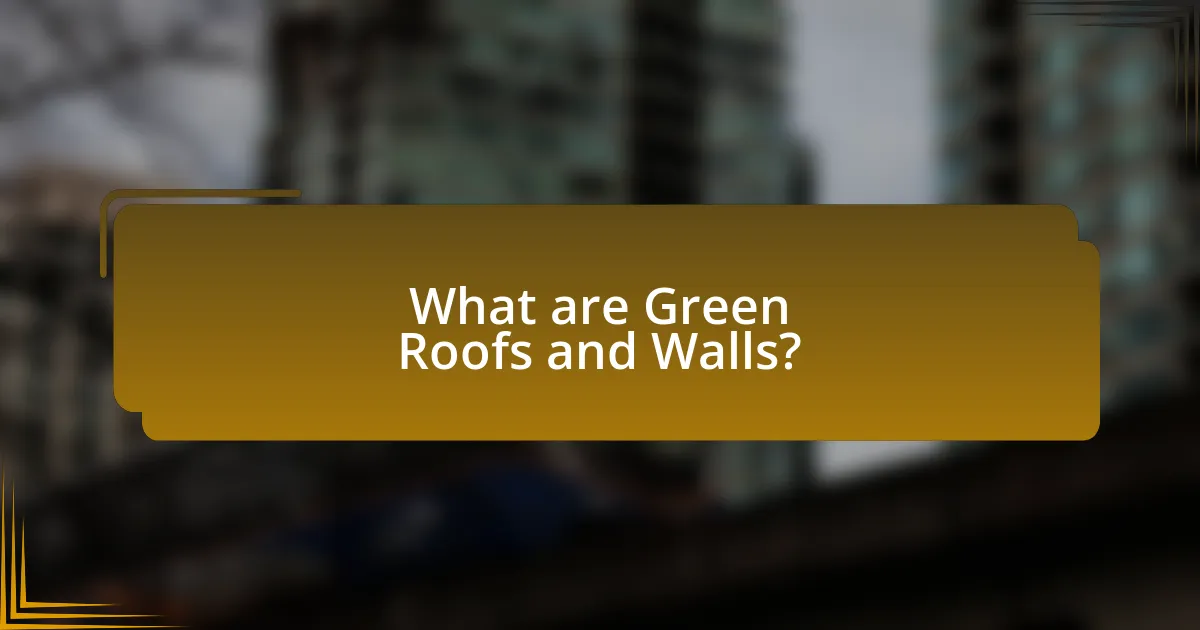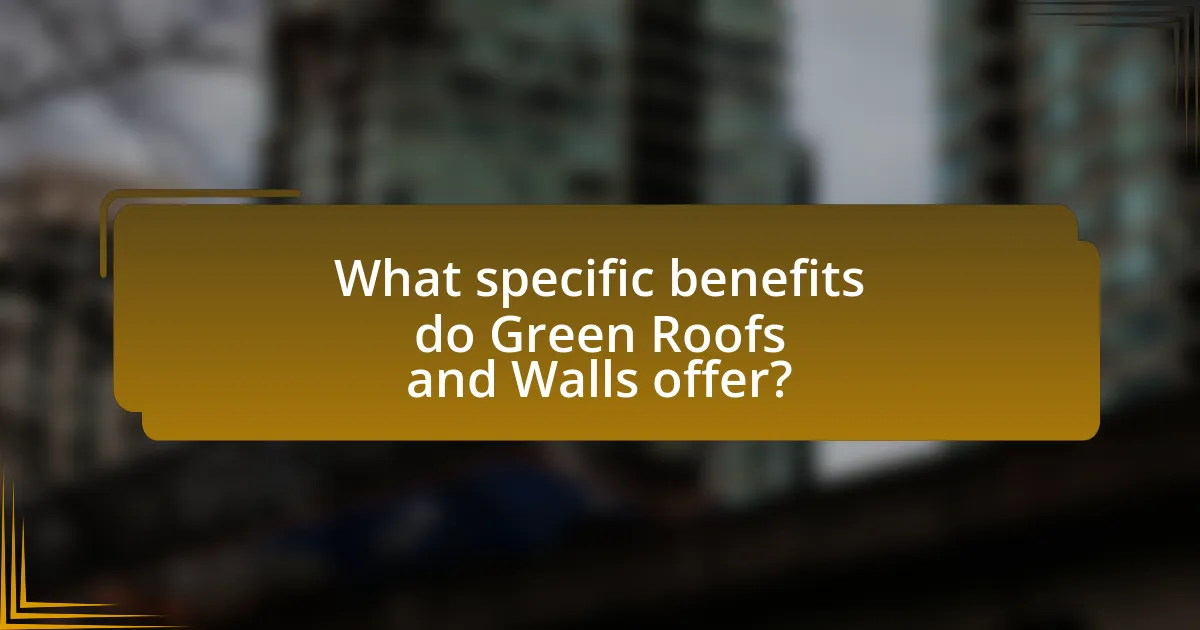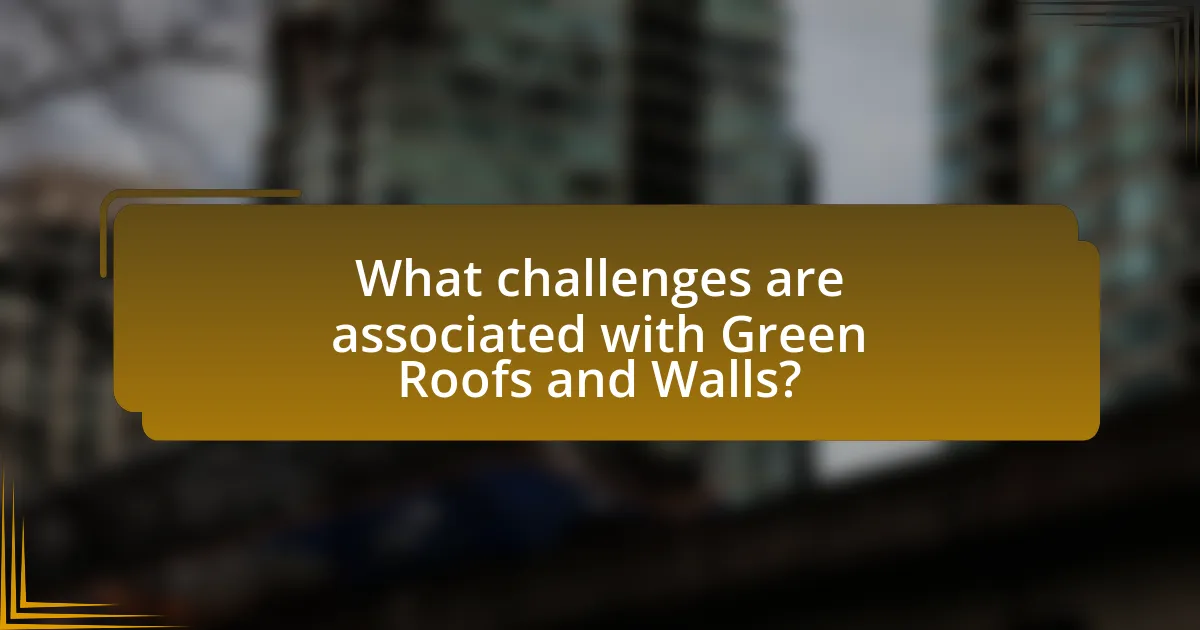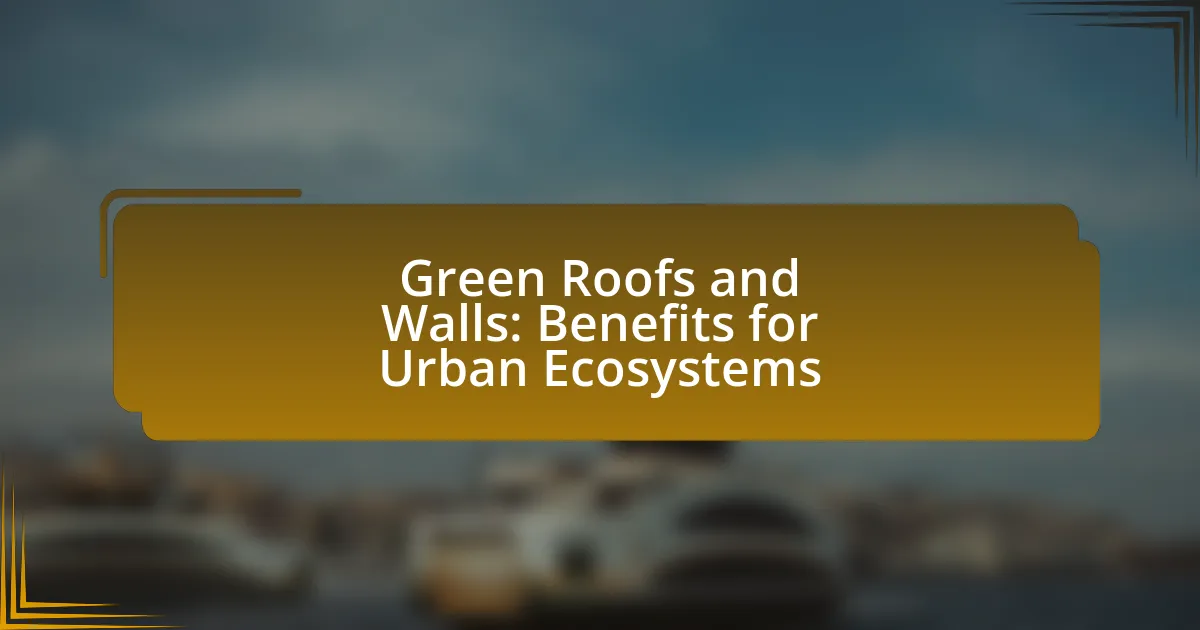Green roofs and walls are innovative systems that integrate vegetation into urban building structures, providing numerous environmental benefits. These systems enhance urban ecosystems by improving air quality, reducing urban heat islands, managing stormwater, and supporting biodiversity. The article explores the materials used in green roofs and walls, their functionality in urban settings, and the specific advantages they offer, such as energy efficiency and pollution reduction. Additionally, it addresses the challenges associated with their implementation, maintenance requirements, and the importance of community involvement and supportive policies in maximizing their effectiveness.

What are Green Roofs and Walls?
Green roofs and walls are systems that incorporate vegetation into building structures, enhancing urban environments. These systems consist of layers that support plant growth, including a waterproof membrane, a drainage layer, and a growing medium, allowing for various types of plants to thrive. Research indicates that green roofs can reduce urban heat islands, improve air quality, and manage stormwater runoff effectively, contributing to sustainable urban ecosystems. For instance, a study published in the journal “Environmental Science & Technology” found that green roofs can reduce surface temperatures by up to 40% compared to conventional roofs, demonstrating their significant environmental benefits.
How do Green Roofs and Walls function in urban environments?
Green roofs and walls function in urban environments by providing insulation, reducing heat island effects, managing stormwater, and enhancing biodiversity. These systems utilize vegetation to absorb rainwater, which mitigates flooding and reduces runoff, thereby improving water quality. Studies indicate that green roofs can lower building energy costs by up to 75% during summer months due to their insulating properties. Additionally, they contribute to urban biodiversity by creating habitats for various species, which is crucial in densely populated areas where natural habitats are limited.
What materials are typically used in Green Roofs and Walls?
Green roofs and walls typically use materials such as waterproof membranes, drainage layers, growing media, and vegetation. Waterproof membranes prevent water infiltration into the building, while drainage layers facilitate excess water removal, ensuring proper moisture levels for plant growth. Growing media, which can include soil or engineered substrates, provides nutrients and support for the vegetation. Common vegetation types include sedums, grasses, and native plants, chosen for their adaptability to the specific climate and conditions of the green roof or wall. These materials collectively contribute to the functionality and sustainability of green roofs and walls in urban ecosystems.
How do these structures support biodiversity?
Green roofs and walls support biodiversity by providing habitats for various plant and animal species in urban environments. These structures create microhabitats that can sustain diverse flora and fauna, which are often lacking in traditional urban landscapes. Research indicates that green roofs can host up to 150 different plant species and attract pollinators such as bees and butterflies, enhancing local biodiversity. Additionally, they contribute to ecological connectivity by serving as stepping stones for wildlife, allowing species to move between fragmented habitats.
Why are Green Roofs and Walls important for urban ecosystems?
Green roofs and walls are important for urban ecosystems because they enhance biodiversity, improve air quality, and mitigate urban heat effects. These green structures provide habitats for various species, contributing to urban biodiversity; for instance, a study published in the journal “Urban Ecology” found that green roofs can support up to 30 different plant species and various insects. Additionally, they filter pollutants from the air, reducing urban smog and improving overall air quality. Furthermore, green roofs and walls help lower ambient temperatures in cities, with research indicating that they can reduce surface temperatures by up to 40%, thus combating the urban heat island effect.
What environmental benefits do they provide?
Green roofs and walls provide significant environmental benefits, including improved air quality, reduced urban heat island effect, and enhanced biodiversity. They filter pollutants and carbon dioxide from the air, contributing to cleaner urban environments. Studies show that green roofs can lower surface temperatures by up to 40% compared to conventional roofs, thus mitigating heat in urban areas. Additionally, these green structures support various plant and animal species, promoting urban biodiversity and creating habitats in densely populated areas.
How do they contribute to urban heat island mitigation?
Green roofs and walls contribute to urban heat island mitigation by reducing surface and air temperatures through increased vegetation and evapotranspiration. These green installations absorb sunlight, which lowers the heat absorbed by traditional building materials, and they release moisture into the air, cooling the surrounding environment. Studies have shown that green roofs can reduce rooftop temperatures by up to 40% compared to conventional roofs, significantly lowering ambient temperatures in urban areas. Additionally, the presence of vegetation enhances shade and promotes biodiversity, further contributing to a cooler urban climate.

What specific benefits do Green Roofs and Walls offer?
Green roofs and walls provide multiple benefits, including improved air quality, enhanced biodiversity, and energy efficiency. These systems filter pollutants and carbon dioxide, leading to cleaner air in urban environments. Additionally, they create habitats for various species, promoting urban biodiversity. Energy efficiency is achieved through insulation, which reduces heating and cooling costs by up to 25%, as reported by the U.S. Environmental Protection Agency. Furthermore, green roofs and walls manage stormwater by absorbing rainwater, thus reducing runoff and the risk of flooding.
How do Green Roofs and Walls improve air quality?
Green roofs and walls improve air quality by filtering pollutants and absorbing carbon dioxide. These green structures utilize plants that capture particulate matter and other harmful substances from the air, effectively reducing urban air pollution levels. Research indicates that vegetation can remove up to 60% of particulate matter from the air, contributing to cleaner urban environments. Additionally, the process of photosynthesis in plants on green roofs and walls converts carbon dioxide into oxygen, enhancing overall air quality.
What role do they play in reducing pollutants?
Green roofs and walls play a significant role in reducing pollutants by filtering airborne particles and absorbing harmful gases. These green structures utilize vegetation to capture particulate matter, such as dust and soot, which can improve air quality. Studies have shown that green roofs can reduce urban heat islands, leading to lower ozone levels, while also sequestering carbon dioxide, a major greenhouse gas. Additionally, they can mitigate stormwater runoff, which often carries pollutants into waterways, thereby enhancing urban ecosystem health.
How effective are they in capturing carbon dioxide?
Green roofs and walls are highly effective in capturing carbon dioxide, with studies indicating they can absorb between 30% to 50% of CO2 emissions in urban environments. This effectiveness is attributed to their vegetation, which photosynthesizes and sequesters carbon, contributing to improved air quality. Research published in the journal “Environmental Science & Technology” by authors such as Getter and Rowe (2006) supports these findings, demonstrating that green infrastructure can significantly mitigate urban carbon footprints.
In what ways do Green Roofs and Walls enhance stormwater management?
Green roofs and walls enhance stormwater management by absorbing and retaining rainwater, thereby reducing runoff. These systems can capture up to 75% of precipitation, allowing for gradual release into the drainage system, which mitigates flooding and erosion. Additionally, the vegetation and substrate in green roofs and walls filter pollutants from stormwater, improving water quality before it enters the drainage system. Studies have shown that green roofs can reduce peak runoff rates by 30-50%, demonstrating their effectiveness in managing urban stormwater challenges.
How do they reduce runoff and flooding risks?
Green roofs and walls reduce runoff and flooding risks by absorbing rainwater and slowing its release into the drainage system. This absorption can reduce peak runoff by up to 65% during heavy rainfall events, as demonstrated in studies conducted by the University of Toronto, which found that green roofs can retain significant amounts of stormwater. Additionally, the vegetation and soil layers in green roofs and walls provide a natural filtration system, improving water quality and reducing the burden on urban drainage systems.
What systems are in place for water retention and drainage?
Green roofs and walls utilize systems such as extensive and intensive green roof designs, drainage layers, and retention systems to manage water retention and drainage effectively. Extensive green roofs typically feature a lightweight substrate that retains moisture while allowing excess water to drain through a drainage layer, preventing waterlogging. Intensive green roofs, on the other hand, can support deeper soil layers and a wider variety of plants, requiring more complex drainage systems to manage larger volumes of water. Additionally, retention systems like cisterns and permeable pavements are often integrated to capture and store rainwater, further enhancing the water management capabilities of these green infrastructures. These systems collectively contribute to urban ecosystem benefits by reducing stormwater runoff and improving water quality.

What challenges are associated with Green Roofs and Walls?
Green roofs and walls face several challenges, including structural load limitations, maintenance requirements, and plant selection issues. Structural load limitations arise because the additional weight of soil and vegetation can exceed the capacity of existing buildings, necessitating careful engineering assessments. Maintenance requirements involve regular irrigation, weeding, and pest management, which can increase operational costs and labor. Additionally, plant selection issues can complicate the establishment of a sustainable ecosystem, as not all plants thrive in the unique microclimate created by green roofs and walls, potentially leading to plant failure and reduced effectiveness.
What are the common maintenance requirements?
Common maintenance requirements for green roofs and walls include regular inspections, irrigation management, weed control, and plant health monitoring. Regular inspections ensure that the vegetation is thriving and that there are no drainage issues or structural problems. Irrigation management is crucial, especially in dry periods, to maintain plant health and prevent drought stress. Weed control is necessary to prevent invasive species from outcompeting the desired plants, which can disrupt the ecosystem services provided by the green roof or wall. Additionally, monitoring plant health involves checking for pests and diseases, ensuring that the plants are receiving adequate nutrients, and replacing any dead or dying plants to maintain the aesthetic and functional benefits of the green infrastructure.
How can property owners ensure the longevity of these structures?
Property owners can ensure the longevity of green roofs and walls by implementing regular maintenance, selecting appropriate plant species, and ensuring proper drainage systems. Regular maintenance, including weeding, irrigation, and pest control, helps sustain plant health and structural integrity. Choosing native and drought-resistant plants reduces the need for excessive watering and enhances resilience. Additionally, a well-designed drainage system prevents water accumulation, which can lead to structural damage. Studies indicate that properly maintained green roofs can last over 40 years, significantly extending their lifespan compared to traditional roofing systems.
What are the costs associated with installation and upkeep?
The costs associated with installation and upkeep of green roofs and walls typically range from $10 to $25 per square foot for installation, depending on the complexity and materials used. Maintenance costs generally average between $0.75 and $2 per square foot annually, which includes irrigation, weeding, and plant replacement. These figures are supported by a study from the National Research Council, which highlights that while initial installation can be higher than traditional roofing, the long-term benefits, such as energy savings and stormwater management, often offset these costs.
How can urban planners effectively integrate Green Roofs and Walls into city designs?
Urban planners can effectively integrate Green Roofs and Walls into city designs by incorporating them into zoning regulations and building codes. This integration ensures that new developments include green infrastructure as a standard practice rather than an optional feature. Studies show that cities with mandatory green roof policies, such as Toronto, have seen a significant increase in green space, which contributes to urban biodiversity and mitigates the urban heat island effect. Additionally, planners can incentivize the installation of green roofs and walls through tax breaks or grants, encouraging property owners to adopt these sustainable practices. Implementing educational programs about the benefits of green roofs and walls can also foster community support and participation in these initiatives.
What policies support the implementation of these structures?
Policies that support the implementation of green roofs and walls include urban planning regulations, building codes, and financial incentives. Urban planning regulations often mandate the inclusion of green infrastructure in new developments to enhance biodiversity and manage stormwater. Building codes may provide guidelines for structural requirements and maintenance of green roofs and walls, ensuring safety and longevity. Financial incentives, such as tax credits or grants, encourage property owners to invest in these sustainable structures, promoting environmental benefits and energy efficiency. For instance, cities like Toronto have implemented policies that require green roofs on new buildings, demonstrating the effectiveness of regulatory frameworks in promoting urban greening initiatives.
How can community involvement enhance their effectiveness?
Community involvement can enhance the effectiveness of green roofs and walls by fostering local support and ensuring that these installations meet the specific needs of the community. Engaged communities are more likely to advocate for the maintenance and improvement of green infrastructure, leading to better environmental outcomes. For instance, studies have shown that when residents participate in the planning and implementation of green roofs, the projects are more likely to succeed and be maintained over time, as seen in the case of the Chicago Green Roof Initiative, which reported increased community satisfaction and environmental benefits.
What best practices should be followed when implementing Green Roofs and Walls?
Best practices for implementing Green Roofs and Walls include selecting appropriate plant species, ensuring proper structural support, and incorporating efficient drainage systems. Choosing native and drought-resistant plants enhances biodiversity and reduces maintenance needs, while structural support must accommodate the weight of soil and vegetation. Efficient drainage systems prevent water accumulation, which can lead to structural damage. Research indicates that well-designed green roofs can reduce urban heat islands by up to 5 degrees Celsius, demonstrating their effectiveness in urban ecosystems.
